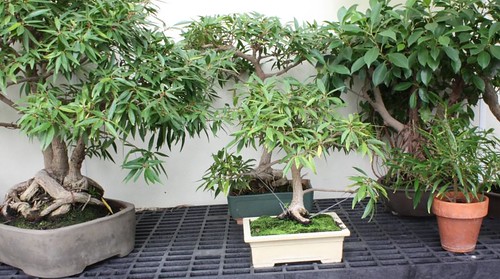Some of my plants have been surprising me with blooms lately. I figured the lower sun angle would be enough to trigger dormancy in some plants, even in the 65 degree temperatures of the greenhouse. But none of my plants are going dormant and some of them are blooming for the first time.
Our neighbor across the street (the one who gave me the
Begonia cuttings) is letting me overwinter her variegated Bougainvillea in my greenhouse. It is in a hanging pot along a rod I installed in the top of the greenhouse and has just been hanging in there. It didn't have a lot of leaves when I took it from her and I haven't seen very many new ones form. But all of the sudden, it is blooming! I think I will have to run it over to her house soon (on a warmish day) and show her the blooms.
 |
| First blooms from my Bougainvillea plant |
I also have a Bougainvillea that was my Mom's. She gave it to me about three years ago. It has had moments of rapid growth and lots of new leaves, but always drops its leaves and looks really sad in the winter - until the greenhouse. It has been pretty happy this winter in the greenhouse and is actually producing the first blooms that I have seen on it since it has been in my care!
 |
| New blooms on my purple shrimp plant (Justicia scheidweileri) |
I bought
several Shrimp plants last Spring and Summer, most of which were blooming when I bought them and have continued to do so. One of them, the
Purple Shrimp Plant (Justicia scheidweileri), has been particularly difficult, though. It wilts quicker than another other plant that I grow. But it also bounces back quickly and is blooming for the first time since it lost its initial blooms.
After forming some small white flowers, which I didn't photograph in time, my
Ying Yang Bean plants (Phaseolus vulgaris) are now forming pods of new beans. I hope to get a decent crop from these plants, so that I can keep a bean or two myself and share the others with other local greenhouse owners.
 |
| Newest bloom on my yellow Datura |
My lime tree and yellow Datura continue to bloom on a regular basis. I dropped seeds from the Datura parent plant onto the soil under the same plant and some of the have sprouted and are producing new little plants.
 |
| Seedlings of my yellow Datura plant |
I am anxious to see some of my Hawaiian ginger plants bloom, but that might have to wait until this Summer. Some of them are quite large now - over 4 foot tall. I would expect those are pretty close to blooming size.












